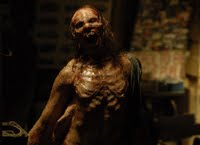 “Any sufficiently advanced technology something something magic.” – Arthur C. Clarke, apparently
“Any sufficiently advanced technology something something magic.” – Arthur C. Clarke, apparentlyRemember when Vampires were good ol’ reliable devil worshippers and hosts to evil spirits? When Vlad was the last word on Vampirism, even up into the goth Vampire The Masquerade / Anne Rice days, a world with vampires was pretty much a world allowing for supernatural events and inhabitations. Sexy, bloodthirsty vampirism was justified by symbolism and folkloric mysticism, and didn’t really depend on empirical verifiability. Has anyone noticed how this has been changing?
Daybreakers is one of the recent movies that's displaced vampire lore from Victorian superstition to post-apocalyptic science fiction. This is a film that starts with a very interesting premise: the world is populated almost entirely by vampires, and their supply of fresh human blood is dwindling… they’ve tried farming, but it can’t keep up with demand, and they’re consistently failing to produce an acceptable blood substitute. The desperation is causing serious civil unrest. It’s tempting to read it as an environmental/sustainability metaphor, but don’t… it just makes it boring.
However, even resisting this impulse, you won’t be able to help seeing this as a very modern premise, based on the sciences of economics and scarcity, and the logic of technological solutions to chronic biological and ecological limitations. It’s an extension of a folkloric monster, operating within a scientific discourse. I Am Legend and Blade both work this way, as well. Compare this with the original, sourcebook vampire legends, Dracula and Nosferatu: in these, the vampire was a predatory master of a supernatural world, governed by laws of the spirit (I’d argue that the Anne Rice and White Wolf vampires are the modern inheritors of this tradition). Also, for arguments’ sake, compare with the image of the vampire as spirituality-on-the-margins: the vampires that represent an inexplicable supernatural presence, but that coexist with modern society, albiet at arm's reach. This is the vampire lore of Twilight and Let The Right One In: vampires don’t represent some ominous, ever-present “other world” so much as the mysterious exception ("the other") to rational society. Whereas the classical vampire represented a threat to “normalcy,” these new vampires are outcasts, representing a sentimental nostalgia for folklore and mysticism.
Kay, typological tangent over. Back to the vampire world of Daybreakers.
 And if the vampires lack this nutrient for too long, they start to degenerate, physically and mentally, which is one of the deliciously awesome twists that Daybreakers brings to Vampire mythology. It might be even better than "torpor," which was Vampire: The Masquerade's state of hibernation for underfed vampires.
And if the vampires lack this nutrient for too long, they start to degenerate, physically and mentally, which is one of the deliciously awesome twists that Daybreakers brings to Vampire mythology. It might be even better than "torpor," which was Vampire: The Masquerade's state of hibernation for underfed vampires.In an even more fascinating stylistic twist, the vampires that don't get enough blood tend to follow a reverse evolution, from Stoker-esque white collar vampire studs to Murnau-esque creatures with bald heads and huge, ragged ears. In fact, Daybreakers is the first vampire movie that I've seen combine the two dominant vampire images. Only Vampire: The Masquerade has done this before, using the Nosferatu clan to fudge in the deformed subspecies. The mental degeneration of these Subsider vampires is harrowing, as they revert to deformed scavengers with no instinct but to feed. The fact that this condition is brought on by feeding from other vampires, and feeding from oneself, associates it with sexual perversity, on top of the addiction and devolution implications.
These rules lay the groundwork for a fairly satisfying science fiction world, mostly rationalized, but with a glaze of mysticism. My main critique of the narrative space is that the Spierig brothers tried too hard to reference the older, folklore-based vampires of Victorian gothica. This goth loyalty resulted in a couple useless details: first, that the vampires are apparently invisible in mirrors; second, that they explode in flames when impaled on a stake.
We all know how various wavelengths of light affect the rods and cones of the eye, and it's a far stretch to assume that the same reflected light that reaches our eyes can vanish when it touches a mirror. Furthermore, it's hard to imagine a biological reaction that incites immediate combustion, but only from the heart, and only when it's impaled on something as inert as a crossbow bolt.
First, I admit, these are details. I'm a big supporter of this movie, and if you need confirmation of that, read my review over at BlogCritics. However, that review will also tell you that in my opinion, it's the innovative conceptual treatment of vampires and society that really makes this a good movie. The silly narrative tropes and campy lines are offensive, but they're also easy to write off as a sort of action movie syndrome. But those inconsistencies in the beautifully-rendered universe of Daybreakers... they're cracks in the core merit of the movie. They break up the texture of a well-rendered world, and thus they merit mention.
Still, it was an easy world to get caught up in, and I give the Spierigs credit for that. The future was not only vampire-y... it was frigid and lonely, disconnected, and desperate. For the vampire citizens of Earth 2019, the world is poised on a razor's edge between the empty stasis of immortality and the suffocating catastrophe of implosion and violence. It's a future wasted, partly by greed, but moreso by the same cruel hand of fate that gave mankind so many gifts and so few promises.

No comments:
Post a Comment